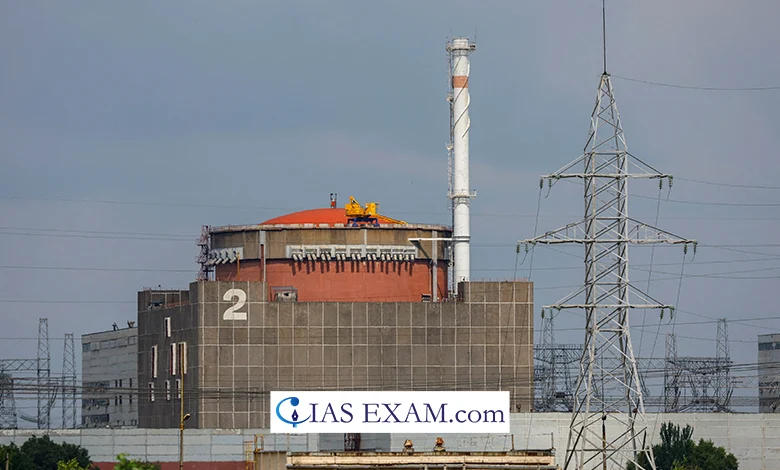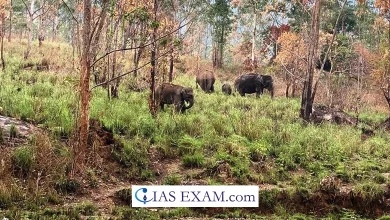Daily Current Affairs for UPSC
Zaporizhzhia Nuclear Power Station
Syllabus- Disaster Management [GS Paper-3]

Context
Russia has recently demanded Western Countries to respond to Ukraine’s strike on the Zaporizhzhia nuclear power station controlled by Russian forces.
About
- The International Atomic Energy Agency, said it was the first time the nuclear plant was directly targeted since 2022 and said the attack had endangered nuclear safety.
- Russian forces took control of the plant in 2022 shortly after their full-scale invasion of Ukraine.
- Both Russia and Ukraine have repeatedly accused each other of risking a nuclear coincidence by attacking the plant.
Zaporizhzhia Nuclear Power Station
- The Zaporizhzhia plant, in southern Ukraine, is the largest nuclear plant in Europe.
- The facility stopped producing energy in 2022, but needs a consistent supply of electricity to cool one of its reactors that’s in a state of “hot conservation”, that means it isn’t completely offline.
Nuclear Disasters
- A nuclear disaster is damage due to the abnormal emission of radiation or radioactive material attributable to an accident, etc. at a nuclear facility.
- It causes deadly outcomes to individuals, massive radioactivity release to the environment, or reactor core melt.
- Worldwide there have been 99 injuries at nuclear power plants.
- 57 injuries have happened since the Chernobyl disaster, and 57% of all nuclear-associated accidents have happened in the USA.
- Serious nuclear power plant accidents consist of the Fukushima Daiichi nuclear disaster (2011), Chernobyl disaster (1986), Three Mile Island accident (1979), and the SL-1 accident (1961).
Concerns Related to Nuclear Disasters
- Radiation Exposure: Exposure to ionizing radiation released in the course of a nuclear catastrophe ends in acute and chronic health results, which includes radiation sickness, cancer, genetic mutations, and reproductive problems.
- Contamination of Air, Water, and Soil: Radioactive particles released into the ecosystem contaminate the air, water bodies, and soil, posing risks to ecosystems, agriculture, and human health through ingestion, inhalation, or absorption.
- Displacement and Evacuation: Nuclear failures often bring about the evacuation and displacement of massive populations from affected areas.
- Economic Costs: The economic expenses related to nuclear failures are vast, along with cleanup and decontamination efforts, healthcare expenses, loss of livelihoods, and long-term environmental remediation.
- Intergenerational Impact: The results of nuclear disasters can span generations, with potential genetic mutations and health issues affecting not only the exposed population but also their descendants.
- Some doctors in Europe recommended pregnant women to undergo abortions because of radiation exposure because of the Chernobyl accident.
- Psychological Impact: Stigmatisation of each exposed and evacuated people following the Nuclear accidents has strongly contributed to a huge upward push in alcoholism, despair, tension, bullying and suicides.
- Challenges in Disaster Response and Management: Responding to nuclear disasters presents specific demanding situations, consisting of the need for specialized systems, trained employees, and coordinated worldwide efforts to mitigate the spread of radiation and control the aftermath successfully.
Safety Measures to Prevent a Nuclear Disaster
- Stringent Regulatory Framework: Governments need to establish and enforce comprehensive regulatory frameworks governing nuclear safety, along with licensing, operational standards, emergency preparedness, and environmental safety.
- Risk Assessment and Management: Authorities must conduct thorough threat assessments to pick out ability risks and vulnerabilities at nuclear centers, and implement risk control techniques to mitigate risks efficiently.
- Design and Engineering Standards: Ensure that nuclear facilities are designed, built, and maintained per rigorous engineering standards to save you injuries and withstand natural disasters.
- Safety Systems: Install multiple layers of safety systems to prevent and mitigate injuries, together with reactor shutdown systems, containment systems, emergency cooling structures, and backup power supplies.
- Operator Training: Provide complete training for nuclear plant operators and personnel, ensuring they have the knowledge, skills, and competence to operate facilities safely and respond effectively to emergencies.
International Regulatory Framework for Preventing Nuclear Disasters
- Convention on Nuclear Safety (CNS): The CNS is a legally binding worldwide treaty that establishes essential safety principles and duties for the secure operation of nuclear power plants.
- Participating states are required to publish national reviews at the implementation of safety measures and undergo peer overview by means of different parties to evaluate compliance with safety standards.
- Joint Convention at the Safety of Spent Fuel Management and at the Safety of Radioactive Waste Management: This conference addresses the safe control and disposal of spent nuclear gas and radioactive waste, aiming to save you injuries and reduce environmental and health dangers associated with radioactive substances.
- Participating states commit to imposing safety measures during the whole lifecycle of radioactive waste, from generation to disposal.
- International Atomic Energy Agency (IAEA): The IAEA performs a primary role in promoting nuclear safety worldwide via its safety standards, suggestions, and technical assistance programs.
- The Agency conducts safety critiques, assessments, and peer reviews of nuclear centers to evaluate compliance with global safety requirements and become aware of areas for improvement.
- Convention on Early Notification of a Nuclear Accident and the Convention on Assistance within the Case of a Nuclear Accident or Radiological Emergency: It followed in 1986 following the Chernobyl nuclear plant coincidence, sets out an worldwide framework for co-operation amongst States Parties and with the IAEA to facilitate prompt help and support in the event of nuclear accidents or radiological emergencies.
Source: The Economic Times
UPSC Prelims Practice Question
Q.In India, why are some nuclear reactors kept under “IAEA safeguards” while others are not? (2020)
(a) Some use uranium and others use thorium
(b) Some use imported uranium and others use domestic supplies
(c) Some are operated by foreign enterprises and others are operated by domestic enterprises
(d) Some are State-owned and others are privately owned
Ans: (b)





.png)



